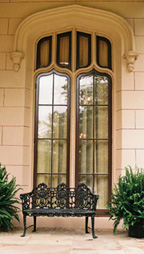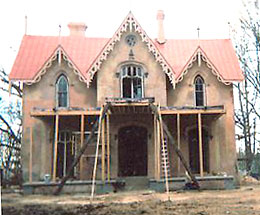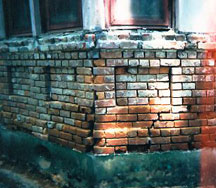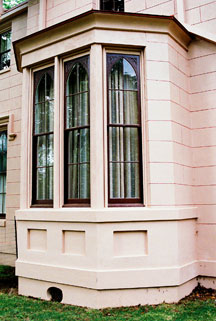 |

Research
for original paint colors
The process of restoration desired by the owners required extensive scientific analysis of samples of stucco, wood trim, boards and plaster. The aim was to find the materials used and what colors they were painted and different treatments.
The paint research was conducted by Matthew J. Mosca, Historical Paint Finishes Consultant, Artifex, Ltd., in Baltimore, Maryland.
 Cross sections of the samples of materials were examined and the first
finish was identified and assigned to a color in the Plochere Color System.
Through the used of polarized-light microscopy, each piece was examined
to determine dating. The report of Mr. Mosca stated: “In every
respect, the aim of the research is to reduce the degree of subjective
judgment as much as possible.”
Cross sections of the samples of materials were examined and the first
finish was identified and assigned to a color in the Plochere Color System.
Through the used of polarized-light microscopy, each piece was examined
to determine dating. The report of Mr. Mosca stated: “In every
respect, the aim of the research is to reduce the degree of subjective
judgment as much as possible.”
Samples of color were identified according to the Plochere Color System and the International Commission on Illumination. Tests were conducted in a controlled lighting environment using filtered tungsten halogen to simulate daylight.
The stucco:
Analysis revealed that the original finish was painted with a warm light
brown color to suggest stone, which was articulated with red ochre
lines, suggesting red mortar joints. The stucco color was applied first
with the red lines added to complete the effect of mortar and ashlar
blocks.
 Th
Th e colors were identified and assigned to a number in the Plochere
Color System. The stucco color was a light pinkish tan (Plochere 230)
and the mortor lines were a moderate brownish red (Plochere 361).
e colors were identified and assigned to a number in the Plochere
Color System. The stucco color was a light pinkish tan (Plochere 230)
and the mortor lines were a moderate brownish red (Plochere 361).
Mr. Mosca noted that the mortar lines were applied with a pencil brush, a very thin brush that is a common tool of artists, thus the technique was called “penciling.” The example at Airliewood was done with a red iron oxidide pigment. The variation of color of the mortar lines is due to the variation of the thickness of the paint.
Analysis of wood board of the exterior of the house revealed that sand was applied to the wet first coat of white paint.. The second application of the light pinkish brown color would have made a uniform but textured stone appearance. In many cases, the sanded finish had worn off of the surface.
This technique is noted in Philadelphia architect Samuel Sloan’s plan book. In instructions accompanying the blueprint of a Gothic Villa, Design Forty-Five, Sloan notes: “The head moldings, corbels, porch supporting the library and the carriage drive, should be painted and sanded to represent stone.”
Mosca found the paint treatment of three quarter round molding to be the same of the stucco with “sand thrown against the wet paint” following an prime coat of lead white in oil prime and an undercoat of the light pinkish tan.
Following his analysis, Mosca published his conclusions and recommendations for a finish schedule in the restoration of Airliewood.
“The exterior of the Overstreet House was finished in a manner to simulate stone blocks with red mortar. This type of exterior decoration was not uncommon in the mid-nineteenth century, however, there are relatively few examples of period stucco that remain to document this type of decoration. In many cases, the stucco was treated to create a faux stone effect either with paint, similar to marbling, or with chemicals.
“The writer has worked on two buildings of this type: the Lyceum
of Alexandria, Va., (ca. 1845) and the Old Lynchburg (Va.) Courthouse
(ca. 1855).The former had the original specifications surviving which
described the stucco as to be created in grained freestone, i.e., to
simulate Aquia sandstone. Little of the actual stucco survived. At the
Old Lynchburg Courthouse, the scored stucco was finished in Roman Cement,
which involved the process of ferrous sulfate staining.
“The Overstreet House is simpler, but no less effective, effect. Both
the stucco and the flat wood boards should be finished to suggest ashlar blocks,
based on the examples remaining on the site. The larger pieces of woodwork
also appear to have been finished to look like stone, thus the finding of the
sanded finish on the quarter round molding.”